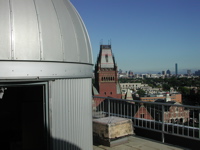
Harvard University
Astronomy Lab and Clay Telescope

 |
Harvard UniversityAstronomy Lab and Clay Telescope |
 |
Day Labs | Evening Labs | Cloudy Day Labs | MaximDL Help
Measure Elevation and Azimuth of Jupiter and Aldebaran
This lab should serve as an introduction to the night sky. Positions of celestial objects on the sky are measured with two angles: i) azimuth, or the horizontal (in the plane of the ground) angle of the direction to an object vs. the direction to the North, and measured East of North; and ii) elevation, the angle between the object on the sky and the horizon directly below. Celestial positions are changing with time and so three measurements must be made: azimuth, elevation (azimuth and elevation are both in degrees) and time (date and time, to the nearest 30 seconds).
Azimuth angle is the number of degrees from True North. Azimuth angles can then range from 0 degrees (North), to 90 degrees (East), to 180 degrees (South), to 270 degrees (West) and then back to 360 degrees (North). Elevation, also referred to as altitude, angles will range from 0 degrees (on the horizon) to 90 degrees (on the zenith).
What you need:
Procedure: